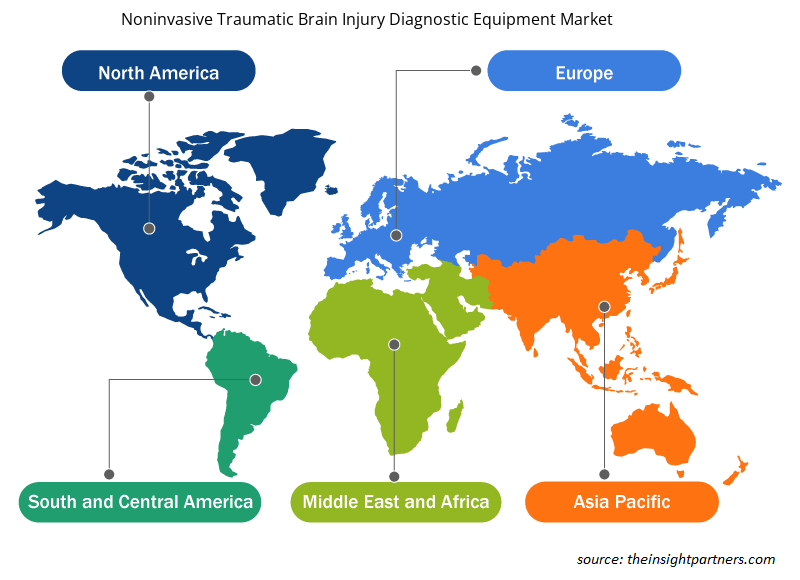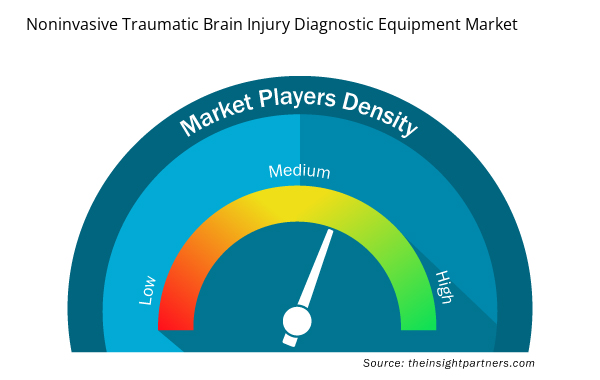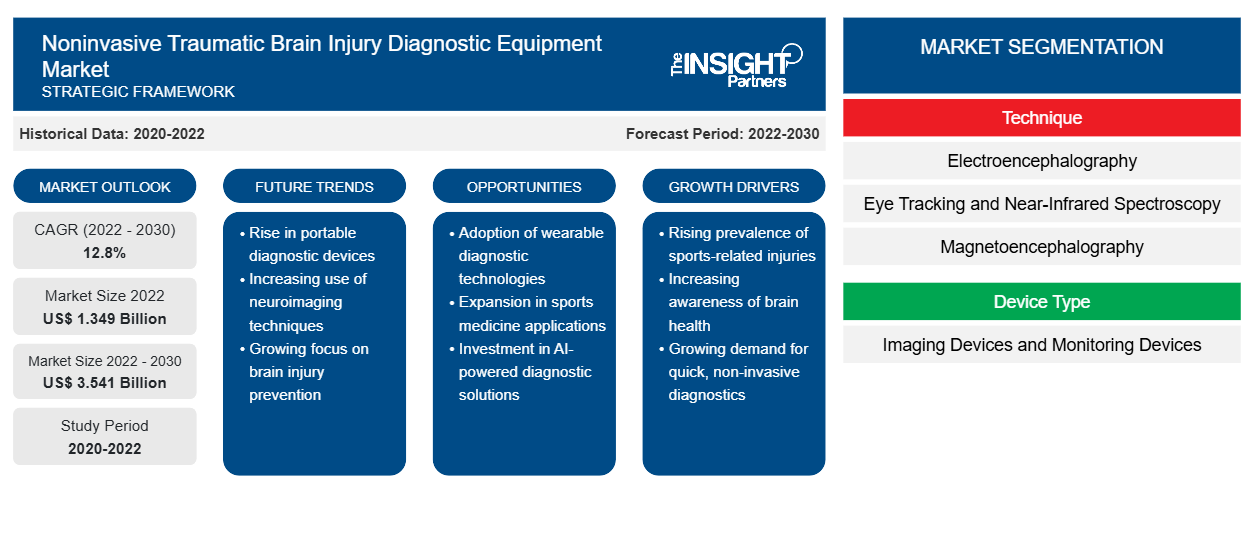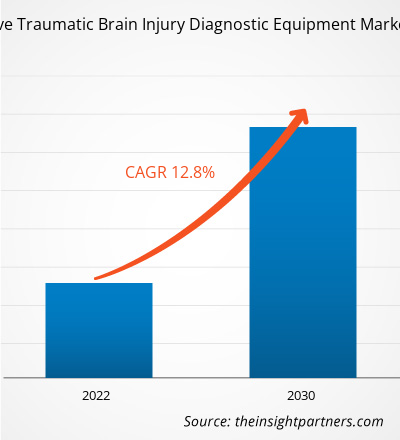[調査レポート] 非侵襲性外傷性脳損傷診断装置市場は、2022年の13億4,900万米ドルから2030年には35億4,100万米ドルに成長すると予測されており、2022年から2030年の間に12.8%のCAGRを記録すると推定されています。
市場洞察とアナリストの見解:
高度な診断機器や TBI 患者の迅速かつ効果的な診断に対する需要の高まりなどの要因により、非侵襲性外傷性脳損傷診断機器市場の成長が促進されています。ただし、造影剤/造影剤の悪影響により、市場の成長が妨げられています。
成長の原動力:
高度な診断機器に対する需要の高まりが非侵襲性外傷性脳損傷診断機器市場の成長を促進
医学研究評議会2022年報告書によると、世界中で毎年1000万人が 外傷性脳損傷(TBI)を負っています。同様に、ヘッドウェイ2024報告書は、英国で後天性脳損傷(ABI)が増加していることが明らかになりました。2019年から2020年にかけて、英国ではABIによる入院が合計356,699件登録されました。これらのうち、頭部外傷で入院した男性人口は女性の1.5倍でした。エコノミスト・インテリジェンス・ユニットの報告書によると、TBIの世界的な医療負担は年間約4,000億米ドルと推定されています。ABIの最も一般的な形態は、事故または脳卒中によるTBIです。疾病管理予防センター(CDC)の報告書によると、米国では毎年推定170万件のTBI関連の救急外来受診、入院、死亡が発生しており、特に75歳以上の成人は歩行やバランスの問題により転倒するリスクが高いため多くなっています。また、米国では交通事故がTBI関連の死亡原因の第1位であり、20~24歳の成人の間で最も高くなっています。そのため、メーカーはTBIを診断するための革新的な製品を開発しています。2023年10月、ビオメリューは軽度外傷性脳損傷(mTBI)患者の評価を改善することを目的とした検査「VIDAS TBI(GFAP、UCH-L1)」のCEマーク取得を発表しました。VIDAS TBI(GFAP、UCH-L1)検査は、脳損傷後1時間から血流に放出される2つの脳バイオマーカーであるグリア線維性酸性タンパク質(GFAP)とユビキチンC末端加水分解酵素L1(UCH-L1)の濃度を測定します。これは、損傷後最大12時間の検査ウィンドウを提供する解釈しやすい検査であり、救急科での総検査時間を短縮するのに役立ちます。この製品は、2023 年に一部のヨーロッパ、北アフリカ、南米市場で発売され、世界展開は 2024 年または 2025 年に予定されています。
要件に合わせてレポートをカスタマイズする
このレポートの一部、国レベルの分析、Excelデータパックなど、あらゆるレポートを無料でカスタマイズできます。また、スタートアップや大学向けのお得なオファーや割引もご利用いただけます。
- このレポートの主要な市場動向を入手してください。この無料サンプルには、市場動向から見積もりや予測に至るまでのデータ分析が含まれます。
レポートのセグメンテーションと範囲:
「非侵襲性外傷性脳損傷診断装置市場分析」は、技術、装置タイプ、エンドユーザーというセグメントを考慮して実施されました。
セグメント分析:
技術別に見ると、非侵襲性外傷性脳損傷診断装置市場は、脳波検査、視線追跡および近赤外線分光法、磁気脳波検査、経頭蓋磁気刺激、脳酸素代謝率、磁気共鳴画像法、頭蓋内圧、脳コンピューターインターフェース、脳酸素代謝率などに分類されます。磁気共鳴画像法セグメントは2022年に最大の市場シェアを占めました。視線追跡および近赤外線分光法セグメントは、予測期間中に14.3%という最高のCAGRを記録すると予想されています。
非侵襲性外傷性脳損傷診断装置市場は、装置タイプ別に、画像装置とモニタリング装置に分かれています。画像装置セグメントは2022年に大きな市場シェアを占め、モニタリング装置は予測期間中に14.5%という高いCAGRを記録すると予想されています。
非侵襲性外傷性脳損傷診断装置市場は、エンドユーザー別に、病院・診療所、診断センター、その他に分類されています。病院・診療所セグメントは2022年に最大の市場シェアを占め、診断センターは予測期間中に13.4%という最高のCAGRを記録すると予想されています。TBI患者を診断するためのポータブル非侵襲性モニタリングデバイスの登場は、非侵襲性外傷性脳損傷診断装置として機能する将来のトレンド
組織代謝をモニタリングする新しい非侵襲的方法は、脳震盪、脳卒中、TBI などの脳疾患の診断とモニタリングの改善に役立ち、患者の回復を早めることができます。BrainScope 社のホワイト ペーパーによると、TBI の影響により医療費の負担が増加し、年間 765 億ドルに上ります。ホワイト ペーパーで明らかにされた調査結果によると、救急科やコミュニティ環境 (緊急治療センターを含む) などの費用のかからないケア環境に「BrainScope One」を導入すると、医療費が最大 32.2% 大幅に削減される可能性があります。BrainScope One は不要な CT スキャンを排除するのに役立ち、TBI の医療費を削減します。したがって、脳疾患の診断とモニタリングの進歩により、今後数年間で非侵襲性外傷性脳損傷診断機器市場のトレンドに新たな道が開かれる可能性があります。
地域分析:
非侵襲性外傷性脳損傷診断装置市場レポートの範囲は、北米、ヨーロッパ、アジア太平洋、南米および中米、中東およびアフリカをカバーしています。2022年には、北米が最大の非侵襲性外傷性脳損傷診断装置市場シェアを占めました。米国は北米市場における最大の貢献国です。米国疾病管理予防センター(CDC)の報告書によると、米国では毎年推定250万人がTBIに苦しんでいます。KNAPP&ROBERTSの報告書によると、米国だけで6人に1人のアメリカ人がTBI関連の障害を抱えて生活しており、その数は約530万人に上ります。TBIの罹患率が上昇するにつれて、経済的コストは765億ドルに上ります。765億ドルのうち、115億ドルは直接的な医療費、約650億ドルは間接的なコストです。TBIの主な原因は、転倒(45%)、自動車事故(14.3%)、暴行(10.7%)、不明(19.0%)です。
さらに、センス・ニューロ・ダイアグノスティクスは、出血検出の臨床試験の実施許可を発表しました。FDAの脳神経外科、神経介入、神経診断機器部門によって承認された新しい試験は、2023年6月に開始され、米国、カナダ、インドの30か所で最大300人の患者を対象としています。この非侵襲的技術は、2.5秒以内に360のデータポイントを収集して脳出血や脳卒中の種類を検出する可能性があり、TBIを評価および監視する医師、救急科職員、神経ICUチーム、軍の野戦病院による迅速な対応に役立ちます。さらに、米国を拠点とする企業による、TBI患者の診断結果を改善する革新的な製品の発売は、非侵襲的外傷性脳損傷診断機器市場の成長を刺激します。
業界の発展と将来の機会:
非侵襲性外傷性脳損傷診断装置市場の予測は、この市場の関係者が成長戦略を計画するのに役立ちます。非侵襲性外傷性脳損傷診断装置市場で活動している主要企業による戦略的開発のいくつかを以下に示します。
- 2022年4月、ImekaはGEヘルスケアと提携し、磁気共鳴画像(MRI)の機能を拡張し、脳の健康のための精密医療を進歩させることを発表しました。GEはImekaの非侵襲性神経画像技術をBrainWaveの高度な拡散処理に統合し、研究者や臨床医がMRI信号による脳の損傷を詳細に分析できるようにします。
非侵襲性外傷性脳損傷診断装置市場地域別洞察
予測期間を通じて非侵襲性外傷性脳損傷診断装置市場に影響を与える地域的傾向と要因は、Insight Partners のアナリストによって徹底的に説明されています。このセクションでは、北米、ヨーロッパ、アジア太平洋、中東、アフリカ、南米、中米にわたる非侵襲性外傷性脳損傷診断装置市場のセグメントと地域についても説明します。

- 非侵襲性外傷性脳損傷診断装置市場の地域別データを入手
非侵襲性外傷性脳損傷診断装置市場レポートの範囲
| レポート属性 | 詳細 |
|---|---|
| 2022年の市場規模 | 13億4,900万米ドル |
| 2030年までの市場規模 | 35億4100万米ドル |
| 世界のCAGR(2022年 - 2030年) | 12.8% |
| 履歴データ | 2020-2022 |
| 予測期間 | 2022-2030 |
| 対象セグメント | テクニック別
|
| 対象地域と国 | 北米
|
| 市場リーダーと主要企業プロフィール |
|
非侵襲性外傷性脳損傷診断装置市場のプレーヤー密度:ビジネスダイナミクスへの影響を理解する
非侵襲性外傷性脳損傷診断装置市場は、消費者の嗜好の変化、技術の進歩、製品の利点に対する認識の高まりなどの要因により、エンドユーザーの需要が高まり、急速に成長しています。需要が高まるにつれて、企業は提供を拡大し、消費者のニーズを満たすために革新し、新たなトレンドを活用し、市場の成長をさらに促進しています。
市場プレーヤー密度とは、特定の市場または業界内で活動している企業または会社の分布を指します。これは、特定の市場スペースに、その市場規模または総市場価値に対してどれだけの競合相手 (市場プレーヤー) が存在するかを示します。
非侵襲性外傷性脳損傷診断装置市場で事業を展開している主要企業は次のとおりです。
- GEヘルスケアテクノロジーズ
- エレクタAB
- インテグラライフサイエンスホールディングス株式会社
- ナタスメディカル株式会社
- ラウメディックAG
免責事項:上記の企業は、特定の順序でランク付けされていません。

- 非侵襲性外傷性脳損傷診断装置市場のトップキープレーヤーの概要を入手
競争環境と主要企業:
GE HealthCare Technologies Inc、Elekta AB、Integra LifeSciences Holdings Corp、Natus Medical Inc、Raumedic AG、BrainScope Co Inc、Luciole Medical AG、Soterix Medical Inc、Medtronic Plc、Vivonics Inc、NanoDx Inc、Compumedics Ltd、Sense Diagnostics Inc、NeuraSignal Inc、および Neurovigil Inc は、非侵襲性外傷性脳損傷診断装置市場レポートで紹介されている著名な企業の一部です。これらの企業は、新しい技術の開発、既存製品のアップグレード、および世界中で高まる消費者の需要を満たすために地理的プレゼンスの拡大に重点を置いています。
- 過去2年間の分析、基準年、CAGRによる予測(7年間)
- PEST分析とSWOT分析
- 市場規模価値/数量 - 世界、地域、国
- 業界と競争環境
- Excel データセット


- Online Exam Proctoring Market
- GNSS Chip Market
- Social Employee Recognition System Market
- Vision Guided Robotics Software Market
- Surety Market
- Electronic Toll Collection System Market
- Clinical Trial Supplies Market
- Airport Runway FOD Detection Systems Market
- Dealer Management System Market
- Space Situational Awareness (SSA) Market

Report Coverage
Revenue forecast, Company Analysis, Industry landscape, Growth factors, and Trends

Segment Covered
This text is related
to segments covered.

Regional Scope
North America, Europe, Asia Pacific, Middle East & Africa, South & Central America

Country Scope
This text is related
to country scope.
よくある質問
TBI is a form of acquired brain injury and is categorized as mild, moderate, and severe. Therefore, diagnostics is utilized for effective diagnosis of TBI suffering patients. Computed Tomography (CT), Magnetic Resonance Imaging (MRI), and others are examples of noninvasive TBI diagnostics. Non-Invasive Methods for TBI Assessment mainly implies injuries to the neuronal network and recovery from it involves the forming of new circuits between surviving and damaged neurons, generating additional functional states and new gene expression profiles.
Key factors that are driving the growth of this market are accelerated demand for advanced diagnostic equipment and innovative product launches is expected to boost the market growth for the noninvasive traumatic brain injury diagnostic equipment over the years.
The CAGR of the noninvasive traumatic brain injury diagnostic equipment market during the forecast period of 2022-2030 is 12.8%.
The hospital & clinics segment held the largest share of the market in the global noninvasive traumatic brain injury diagnostic equipment market in 2022.
Global noninvasive traumatic brain injury diagnostic equipment market is segmented by region into North America, Europe, Asia Pacific, Middle East & Africa and South & Central America. North America held the largest market share of the noninvasive traumatic brain injury diagnostic equipment market in 2022.
The noninvasive traumatic brain injury diagnostic equipment market majorly consists of the players such GE HealthCare Technologies Inc, Elekta AB, Integra LifeSciences Holdings Corp, Natus Medical Inc, Raumedic AG, BrainScope Co Inc, Luciole Medical AG, Soterix Medical Inc, Medtronic Plc, Vivonics Inc, NanoDx Inc, Compumedics Ltd, Sense Diagnostics Inc, NeuraSignal Inc, and Neurovigil Inc, and amongst others.
The imaging segment dominated the global noninvasive traumatic brain injury diagnostic equipment market and held the largest market share in 2022.
Trends and growth analysis reports related to Life Sciences : READ MORE..
The List of Companies - Noninvasive Traumatic Brain Injury Diagnostic Equipment Market
- GE HealthCare Technologies Inc
- Elekta AB
- Integra LifeSciences Holdings Corp
- Natus Medical Inc
- Raumedic AG
- BrainScope Co Inc
- Luciole Medical AG
- Soterix Medical Inc
- Medtronic Plc
- Vivonics Inc
- NanoDx Inc
- Compumedics Ltd
- Sense Diagnostics Inc
- NeuraSignal Inc
- Neurovigil Inc
The Insight Partners performs research in 4 major stages: Data Collection & Secondary Research, Primary Research, Data Analysis and Data Triangulation & Final Review.
- Data Collection and Secondary Research:
As a market research and consulting firm operating from a decade, we have published and advised several client across the globe. First step for any study will start with an assessment of currently available data and insights from existing reports. Further, historical and current market information is collected from Investor Presentations, Annual Reports, SEC Filings, etc., and other information related to company’s performance and market positioning are gathered from Paid Databases (Factiva, Hoovers, and Reuters) and various other publications available in public domain.
Several associations trade associates, technical forums, institutes, societies and organization are accessed to gain technical as well as market related insights through their publications such as research papers, blogs and press releases related to the studies are referred to get cues about the market. Further, white papers, journals, magazines, and other news articles published in last 3 years are scrutinized and analyzed to understand the current market trends.
- Primary Research:
The primarily interview analysis comprise of data obtained from industry participants interview and answers to survey questions gathered by in-house primary team.
For primary research, interviews are conducted with industry experts/CEOs/Marketing Managers/VPs/Subject Matter Experts from both demand and supply side to get a 360-degree view of the market. The primary team conducts several interviews based on the complexity of the markets to understand the various market trends and dynamics which makes research more credible and precise.
A typical research interview fulfils the following functions:
- Provides first-hand information on the market size, market trends, growth trends, competitive landscape, and outlook
- Validates and strengthens in-house secondary research findings
- Develops the analysis team’s expertise and market understanding
Primary research involves email interactions and telephone interviews for each market, category, segment, and sub-segment across geographies. The participants who typically take part in such a process include, but are not limited to:
- Industry participants: VPs, business development managers, market intelligence managers and national sales managers
- Outside experts: Valuation experts, research analysts and key opinion leaders specializing in the electronics and semiconductor industry.
Below is the breakup of our primary respondents by company, designation, and region:

Once we receive the confirmation from primary research sources or primary respondents, we finalize the base year market estimation and forecast the data as per the macroeconomic and microeconomic factors assessed during data collection.
- Data Analysis:
Once data is validated through both secondary as well as primary respondents, we finalize the market estimations by hypothesis formulation and factor analysis at regional and country level.
- Macro-Economic Factor Analysis:
We analyse macroeconomic indicators such the gross domestic product (GDP), increase in the demand for goods and services across industries, technological advancement, regional economic growth, governmental policies, the influence of COVID-19, PEST analysis, and other aspects. This analysis aids in setting benchmarks for various nations/regions and approximating market splits. Additionally, the general trend of the aforementioned components aid in determining the market's development possibilities.
- Country Level Data:
Various factors that are especially aligned to the country are taken into account to determine the market size for a certain area and country, including the presence of vendors, such as headquarters and offices, the country's GDP, demand patterns, and industry growth. To comprehend the market dynamics for the nation, a number of growth variables, inhibitors, application areas, and current market trends are researched. The aforementioned elements aid in determining the country's overall market's growth potential.
- Company Profile:
The “Table of Contents” is formulated by listing and analyzing more than 25 - 30 companies operating in the market ecosystem across geographies. However, we profile only 10 companies as a standard practice in our syndicate reports. These 10 companies comprise leading, emerging, and regional players. Nonetheless, our analysis is not restricted to the 10 listed companies, we also analyze other companies present in the market to develop a holistic view and understand the prevailing trends. The “Company Profiles” section in the report covers key facts, business description, products & services, financial information, SWOT analysis, and key developments. The financial information presented is extracted from the annual reports and official documents of the publicly listed companies. Upon collecting the information for the sections of respective companies, we verify them via various primary sources and then compile the data in respective company profiles. The company level information helps us in deriving the base number as well as in forecasting the market size.
- Developing Base Number:
Aggregation of sales statistics (2020-2022) and macro-economic factor, and other secondary and primary research insights are utilized to arrive at base number and related market shares for 2022. The data gaps are identified in this step and relevant market data is analyzed, collected from paid primary interviews or databases. On finalizing the base year market size, forecasts are developed on the basis of macro-economic, industry and market growth factors and company level analysis.
- Data Triangulation and Final Review:
The market findings and base year market size calculations are validated from supply as well as demand side. Demand side validations are based on macro-economic factor analysis and benchmarks for respective regions and countries. In case of supply side validations, revenues of major companies are estimated (in case not available) based on industry benchmark, approximate number of employees, product portfolio, and primary interviews revenues are gathered. Further revenue from target product/service segment is assessed to avoid overshooting of market statistics. In case of heavy deviations between supply and demand side values, all thes steps are repeated to achieve synchronization.
We follow an iterative model, wherein we share our research findings with Subject Matter Experts (SME’s) and Key Opinion Leaders (KOLs) until consensus view of the market is not formulated – this model negates any drastic deviation in the opinions of experts. Only validated and universally acceptable research findings are quoted in our reports.
We have important check points that we use to validate our research findings – which we call – data triangulation, where we validate the information, we generate from secondary sources with primary interviews and then we re-validate with our internal data bases and Subject matter experts. This comprehensive model enables us to deliver high quality, reliable data in shortest possible time.


 このレポートの無料サンプルを入手する
このレポートの無料サンプルを入手する